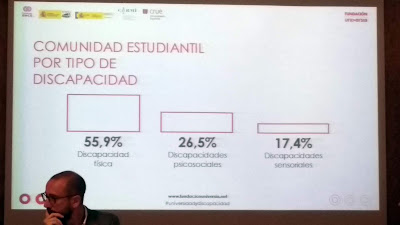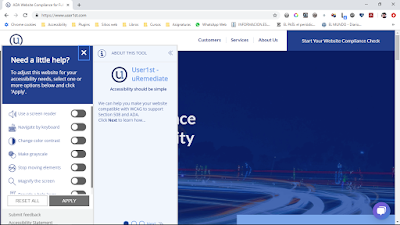se acaba de publicar. El contenido del libro es:
Front Matter
Pages i-xxiii
Understanding Disabilities
Front Matter
Pages 1-1
Visual Disabilities
Armando Barreto, Scott Hollier
Pages 3-17
Physical Disabilities
Shari Trewin
Pages 19-33
Deafness and Hearing Loss
Raja Kushalnagar
Pages 35-47
Cognitive and Learning Disabilities
Lisa Seeman, Clayton Lewis
Pages 49-58
Situationally-Induced Impairments and Disabilities
Jacob O. Wobbrock
Pages 59-92
Ageing and Older Adults
Sri Kurniawan, Andrew Arch, Sean-Ryan Smith
Pages 93-119
Speech and Language
Abi Roper, Stephanie Wilson, Timothy Neate, Jane Marshall
Pages 121-131
Conducting Research
Front Matter
Pages 133-133
Inclusive Writing
Tom Babinszki, Anna Cavender, Michael Gower, Jeffery Hoehl, Darcy Lima, Erich Manser et al.
Pages 135-152
Working With Participants
Christopher Power, Helen Petrie
Pages 153-168
Working with Companies, Charities and Governmental Organisations
Andrew Arch, Lisa Seeman, Sarah Pulis, Glenda Sims
Pages 169-183
End-User Evaluations
Sukru Eraslan, Chris Bailey
Pages 185-210
Reproducible and Sustainable Research Software
Caroline Jay, Robert Haines
Pages 211-221
Society and Standards
Front Matter
Pages 223-223
Standards, Guidelines, and Trends
Shadi Abou-Zahra, Judy Brewer
Pages 225-246
Web Accessibility Policy and Law
Jonathan Lazar
Pages 247-261
Tackling the Inaccessibility of Websites in Postsecondary Education
Jane Seale, Sheryl Burgstahler, Björn Fisseler
Pages 263-279
Policy and Standards on Web Accessibility for Cognitive and Learning Disabilities
Clayton Lewis, Lisa Seeman
Pages 281-299
Inclusion
Cynthia C. Shelly
Pages 301-313
Technical Foundations
Front Matter
Pages 315-315
Assistive Technologies
Hugo Nicolau, Kyle Montague
Pages 317-335
Documents and Publications
Vivienne Conway, Amanda Mace
Pages 337-355
Inclusively Designed Authoring Tools
Jutta Treviranus, Jan Richards, Colin Clark
Pages 357-372
Dynamic Web Content
Renata Pontin de Mattos Fortes, Humberto Lidio Antonelli, Willian Massami Watanabe
Pages 373-395
Scientific Documents
Volker Sorge, Dragan Ahmetovic, Cristian Bernareggi, John Gardner
Pages 397-415
Mathematics and Statistics
Neil Soiffer, Steve Noble
Pages 417-443
Usability, Universal Usability, and Design Patterns
David Sloan, Sarah Horton
Pages 445-460
Multimedia Accessibility
Carlos Duarte, Manuel J. Fonseca
Pages 461-475
Techniques and Tools
Front Matter
Pages 477-477
Tools for Web Accessibility Evaluation
Julio Abascal, Myriam Arrue, Xabier Valencia
Pages 479-503
Automatic Web Accessibility Metrics
Giorgio Brajnik, Markel Vigo
Pages 505-521
Tools and Applications for Cognitive Accessibility
K. Miesenberger, C. Edler, P. Heumader, A. Petz
Pages 523-546
User Interface Adaptation for Accessibility
Sergio Firmenich, Alejandra Garrido, Fabio Paternò, Gustavo Rossi
Pages 547-568
Transcoding
Chieko Asakawa, Hironobu Takagi, Kentarou Fukuda
Pages 569-602
Technologies for Dyslexia
Maria Rauschenberger, Ricardo Baeza–Yates, Luz Rello
Pages 603-627
Alternative Nonvisual Web Browsing Techniques
I. V. Ramakrishnan, Vikas Ashok, Syed Masum Billah
Pages 629-649
Education and STEM on the Web
Barbara Leporini, Marina Buzzi
Pages 651-674
Ubiquitous Web Accessibility
Front Matter
Pages 675-675
Wayfinding
Daisuke Sato, Hironobu Takagi, Chieko Asakawa
Pages 677-700
Wearables
Shaun K. Kane
Pages 701-714
Tangible Interfaces
Mark S. Baldwin, Rushil Khurana, Duncan McIsaac, Yuqian Sun, Tracy Tran, Xiaoyi Zhang et al.
Pages 715-735
Mobile Web
Tiago Guerreiro, Luís Carriço, André Rodrigues
Pages 737-754
Fabrication, 3D Printing, and Making
Amy Hurst
Pages 755-776
Internet of Things: An Opportunity for Advancing Universal Access
Federica Cena, Amon Rapp, Ilaria Torre
Pages 777-790
Futurama
Yeliz Yesilada, Simon Harper
Pages 791-803
Back Matter
Pages 805-807


























